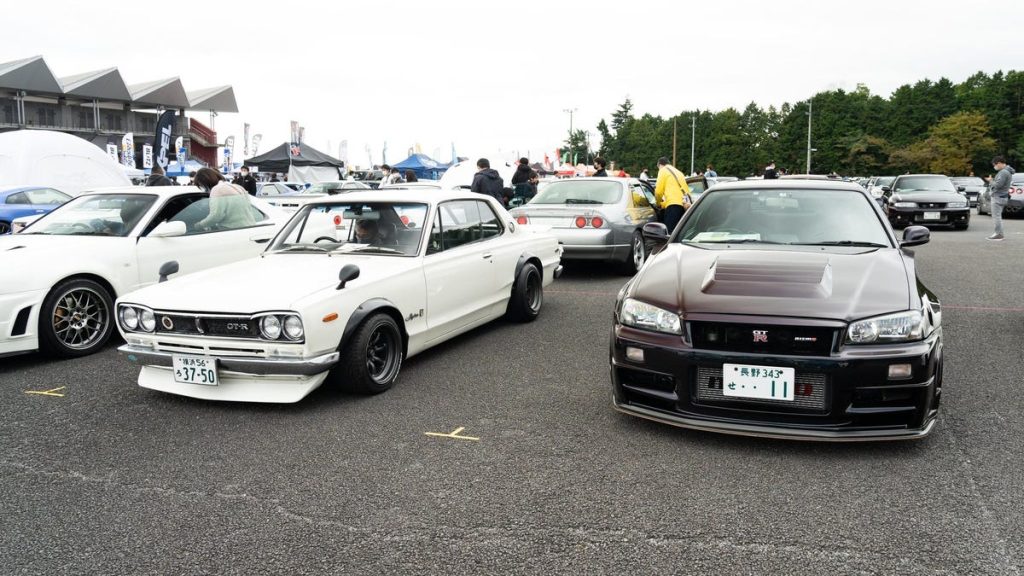Inside R’s Meeting, the Biggest, Most Amazing GT-R Gathering in the World

Photo: Tim Stevens
Nestled in the hills about an hour and a half southwest of Tokyo lies a special place called Fuji Speedway, one of Japan’s premier racing circuits. It’s run all sorts of iconic racing series since it opened in 1965, everything from NHRA to Formula One. But once a year for the past 13 years, that track has hosted a special event that’s a little different. It’s called R’s Meeting. Once upon a time it was something like a casual, brand-specific cars and coffee gathering. Today, it has evolved into the world’s largest get-together for Nissan GT-R owners and enthusiasts. This year, I was lucky enough to go.
(Full Disclosure: I wanted to go to Japan so badly that I bought my own flight and paid for my own damn hotel room, thank you very much. That said, Nissan was kind enough to loan me a Fairlady Z NISMO to drive out to R’s Meeting – but I still had to pay for tolls and gas myself.)
Photo: Tim Stevens
The event took place on Sunday, October 30. I left Tokyo early that morning, dodging most of the incessant traffic that regularly engulfs the Japanese megalopolis, resulting in a mostly pleasant cruise out to Fuji — excepting the wrong turn I made in a little town that sent me navigating through streets barely wider than the 1845 mm that a Fairlady Z measures from mirror to mirror. (To the three children on bikes who watched the gaijin in a pearly NISMO inch through their neighborhood: Thank you for not pointing and laughing.)
Photo: Tim Stevens
G/O Media may get a commission
Good, whole food for your dog.
Nom Nom’s meals are overseen by two Board-Certified Veterinary Nutritionists, who make it their mission to deliver your dog nutrient-rich, healthy foods.
As I pulled into the track I immediately knew I was in for a good day. Fuji’s many parking lots were bursting with thousands of GT-Rs of every age, ranging from the iconic 1969 Hakosuka all the way up to the clinically bonkers R35. Even more were on the track, tearing around and making a glorious sound. I parked in the infield paddock, stepped out of my borrowed Z, and practically tripped over something magnificent.
A pair of period-aged gentlemen in period-appropriate attire were putting the final touches on a very special car: Kunimitsu Takahashi’s 1972 Fuji Grand Champion Series-winning GT-R, still clad in its simple white and blue livery. Takahashi-san was famous for his tail-out racing style, sliding through corners so dramatically that many call him the true father of Japanese drifting. He sadly passed away this past March at the age of 82, and his car was here to run in his honor.
Photo: Tim Stevens
After a final few moments of fiddling with the carbs, one of the engineers gave a thumbs-up and the other hit the ignition. I’ve spent enough time in race garages to know better, but I was too busy adjusting the exposure on my camera to cover my ears, which were ringing for the rest of the day from the fury that little Nissan produced in the echoing confines of the garage.
A memorial to Kunimitsu TakahashiPhoto: Tim Stevens
It was a beautiful song, but I couldn’t linger to enjoy it. I was set to meet with a member of Japanese royalty. Hiroshi Tamura is often called Mister GT-R, having had a hand in engineering every generation of Nissan’s ultimate performance car since the R33. These days he’s something like a spiritual figurehead at Nissan. As I arrived, he was standing next to two iconic GT-Rs, the Mine’s R33 and R34, which I’d bet many of you have sampled in one iteration of Gran Turismo or another. (I know I certainly have.) The turquoise blue of their kevlar dive planes paired nicely with Tamura-san’s perfectly tailored gray suit.
Hiroshi Tamura, center, is known as “Mr. GT-R” for his involvement in developing several generations of the Nissan performance car.Photo: Tim Stevens
I had a scheduled interview with the man, but he was absolutely mobbed by supporters and friends. As it turns out, Tamura-san was in the process of personally thanking every GT-R tuner who’d set up a stand at this year’s show. This was going to take awhile. My interview would have to wait.
Photo: Tim Stevens
So I moseyed around the vendors instead, marveling at the wares up for offer. On the affordable side, one shop had a huge array of leather patches and swatches, samples to perfectly match the interior of any GT-R. Most tents, though, were filled with more expensive fare, like wheels from Rays, seats from Bride, and specialized components like a carbon-fiber driveshaft from Kansai Service for 299,200 yen – about $2,200 at current exchange rates.
I don’t even own a GT-R, but I wanted to take all this stuff home.
Photo: Tim Stevens
The most exotic single component I saw, however, was a complete RB26DETT engine, still in the crate, with the high-compression NISMO head gasket. Price? About $38,000 at the current exchange rate, which honestly seemed like a heck of a bargain to me.
Photo: Tim Stevens
But even that wasn’t the most expensive upgrade. Through a translator, I spoke with a representative from Gifu-based Rush Motor Sports. This company is putting the finishing touches on a complete carbon-fiber body for the R35, replacing every panel. The one on display, in a lush, purple hue, was just a prototype, but they expect to be in production within the next few months. The cost? The representative quoted me 600 million yen, but I think that might have been a translation error. He probably meant 6 million yen, which would be about $43,000. Honestly, though, it looked good enough to be worth $4.3 million, if that initial figure was right.
Photo: Tim Stevens
After scoping out the vendors, I spent hours wandering through the parking lots, drooling over the amazing gathering of machines. The popped hoods and signs and stickers made it all feel like a typical American car show, but I eventually learned the vibe was a little different. In America, every car owner who shows up is eager to talk about their ride. At Fuji Speedway, again and again I was turned away.
“Ohayu gozaimasu,” I’d say. Good morning.
“Ohayu,” they’d say in response.
“Eigo ga wakarimasu ka?” I’d ask. Do you understand English?
“Chotto,” they’d say. A little bit.
“Is this your car? It’s beautiful!” I’d say.
“Thank you very much!” they’d say in absolutely flawless English.
“Can I ask you a few questions about it?” I’d say, taking out my phone to take some notes.
“No, no, no,” they’d say, waving their hands, shooing me away like an annoying fly.
Photo: Tim Stevens
I was told most were probably shy about their English skills, but I did manage to speak with a few, including Tamasaki-san, who showed up in a gorgeous silver R34 he’s owned since new. He’s proudly put over 300,000 kilometers on it. It’s due for a new motor, he said, and parts are getting very expensive, but he still drives it every day and comes to R’s Meeting every year.
As I walked through the parking lot, poking my nose into every open hood and dazzling at the wonders within, I noticed a number of the cars had a scrawling signature on their intakes. Though I sadly cannot read any of Japan’s three character sets very well, I immediately knew whose signature it was: Tamura-san.
Hiroshi Tamura’s signature seen on an R34 GT-R’s air intake.Photo: Tim Stevens
After I’d finished making the rounds, I got my time to speak with Mr. GT-R. I’d met Tamura-san a few years before, when he gave me a ride around Tokyo’s highways at night in a 750-hp Top Secret R32 with an R35 drivetrain. This conversation was a little less dynamic, but he was clearly very excited to see the crowds back at Fuji after a few years of dramatically reduced admissions due to COVID.
“Ten thousand people only coming together for the GT-R festival, the biggest cars and coffee,” he said with a smile.
Photo: Tim Stevens
Might we ever see something like this in the U.S.? The GT-R has a growing appreciation among American car enthusiasts, kicked off by the R34’s starring role in the Fast & Furious series and Gran Turismo.
“I’m sure that customer expectation is going higher and higher,” Tamura-san told me. “But from a business standpoint, I’m not so sure.” One problem: While there may be more GT-R fans in the U.S. than ever before, they’re spread around a very large country. Fuji Speedway, on the other hand, is only a few hours away from most of Japan.
Are the F&F movies popular in Japan? “Yeah,” Tamura-san said noncommittally, then gestured to the crowd. “Please ask them.”
Photo: Tim Stevens
I also asked him for any hints about an R36-generation GT-R. Other than decrying the complexities of designing a good car that meets all the homologation requirements for markets around the globe, he wasn’t willing to share any juicy details yet.
I also spoke with Kouya Noda, the Editor-in-Chief of GT-R Magazine and the organizer of the event. GT-R Magazine is one of Japan’s most popular specialist auto publications, in print since 1994 with a current circulation of 30,000.
Photo: Tim Stevens
Interestingly, as the popularity of R’s Meeting has exploded, Noda-san told me (via translator) that the feeling of the event has changed, too: “Because the GT-R is getting more rare or getting higher value, everybody wants to keep it as original. Before, in the day, we used to modify a lot — more power, more speed. Right now, people get to respect it, keep it plain, keep it beautiful. It’s really different.”
He said more than 2,000 GT-Rs were there this year, down from peak levels but much higher than the mid-COVID turnout. Total attendance for the 2022 running was 7,036, way up from the previous year’s 4,218 but again far short of pre-COVID levels. Still, it’s an impressive figure considering Japan is still just beginning to open up after the pandemic.
Photo: Tim Stevens
As I made my way back home from the event, I had plenty of time to ponder the day. That Tokyo traffic meant a 90-minute drive to the speedway became a near-five-hour return trip. As I listened to smooth Japanese jazz on the radio, I couldn’t help thinking about how different the event had been from my expectations. I had a vision of young kids creating wild, heavily-tuned cars. But most of the owners I saw at R’s Meeting were approaching middle age, some with grandkids in tow. It makes sense, given the increasing age of even the R34-generation car, not to mention the six-figure price tag on the current model. But then, even the R35 is now 15 years old.
My chariot for this trip, a JDM Fairlady Z Nismo.Photo: Tim Stevens
That age has changed the character of the event, too, Noda-san said: “When the R35 was released here in Japan, the R34, the R33, the R32 owners said, It’s not a GT-R. It’s too big. It’s different. In the beginning they didn’t like it. But now they get together because they’re like family.”
Maybe that’s a sign that the Fast & Furious films are popular here after all.






